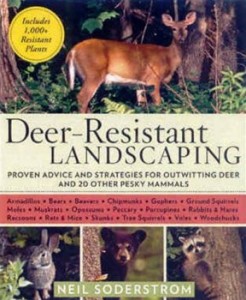Like many northern gardeners, I’ve battled critters pretty much as long as I’ve gardened. At my old house, the issue was raccoons, who had a cozy home in the storm sewer under our street. At my current house, we’ve dealt with mice, pocket gophers, and most recently moles and beavers. Unlike many northern gardeners, deer are not a problem where I live.
If they are a problem where you live, however, run out right now and get Neil Soderstrom’s new book, Deer Resistant Landscaping: Proven Advice and Strategies for Outwitting Deer and 20 Other Pesky Mammals. Soderstrom offers a sane approach to dealing with unwanted garden visitors. Readers learn why these creatures are in our landscapes, what their role in the environment is, and what you can do to discourage their presence or live peacefully with them. The book focuses first and foremost on deer, including in-depth profiles of nearly 200 plants deer don’t like.
 While that is extremely helpful information, it’s Soderstrom’s discussion of animal behavior that is most interesting. For instance, expectant deer mothers become very territorial. They spend most of the year traveling with other female relatives, but when they are close to delivery, they head out on their own. Opossums, which seem more prevalent here the last couple of years, move their dens every few nights, and while they can be a terror if they get in your garage, opossums are helpful in that they feed heavily on snails and keep the populations of mice and voles down. Mice enjoy making nests in the spare tire well of cars and while voles breed pretty much constantly, moles breed only once a year.
While that is extremely helpful information, it’s Soderstrom’s discussion of animal behavior that is most interesting. For instance, expectant deer mothers become very territorial. They spend most of the year traveling with other female relatives, but when they are close to delivery, they head out on their own. Opossums, which seem more prevalent here the last couple of years, move their dens every few nights, and while they can be a terror if they get in your garage, opossums are helpful in that they feed heavily on snails and keep the populations of mice and voles down. Mice enjoy making nests in the spare tire well of cars and while voles breed pretty much constantly, moles breed only once a year.
If you have a critter problem, but aren’t sure what it is, Deer Resistant Landscaping has photos to help you identify it, including shots of animal tracks, tunneling and burrowing systems, mug shots of the various suspects, and critter doo-doo pictures. What I really liked about the book is that Soderstrom helps homeowners consider their options carefully. For instance, the mole who was bugging me last summer is actually eating a lot of bugs in my yard and there’s likely only one mole, so maybe doing nothing — and adjusting how I mow the lawn to camouflage his tunnels – – is the best bet. Soderstrom offers practical advice on how to dispatch animals in the least inhumane way possible and he’s quick to point to the situations that really demand a professional. (Transporting a skunk: No, thank you!)
For sound and responsible advice on dealing with critters, you can’t do much better than this book.
Leave a Reply